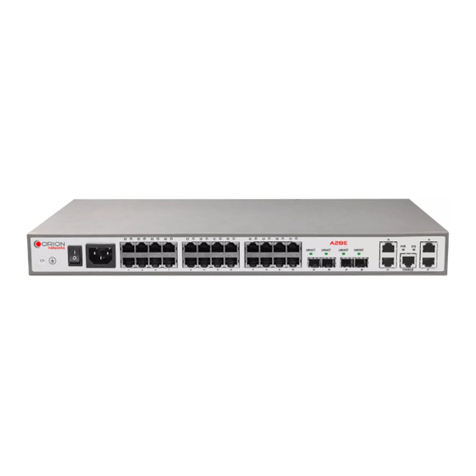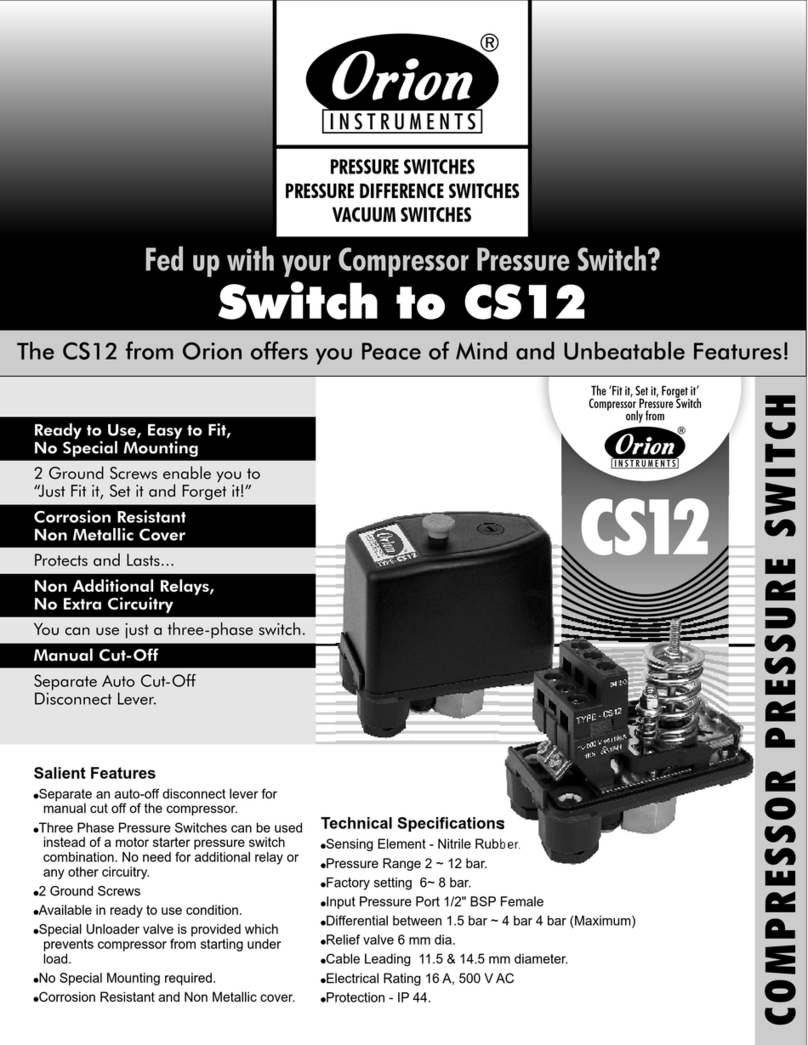Set Point Adjustment:
Ensure the supply is off, before setting the switch. Status of
contacts can be checked with a multimeter / continuity tester.
A) For adjustable differential models
Please refer Figure 2
1) Decide the cut-in (lower) pressure P1 & the cut-out
(upper) pressure P2. The differential will be (P2 – P1).
2) Remove the cover.
3) Set the cut-in point on the main-scale with the help of the
set-screw.
4) Turn the differential screw to the extreme positive end.
5) Apply the desired cutout (higher) pressure to the
pressure switch
6) Decrease the differential pressure setting by turning the
differential screw till contacts changeover.
7) Some minor adjustment will be required to achieve the
exact cutin (lower) / cutout (higher) point, which can be
checked with the help of a proper pressure measurement device.
8) Replace the cover back in the position.
Operating Temperatures:
The operating condition temperature restrictions for the KU Switch are as follows:
o o
Ambient : -5 C to +60 C
o o
Operational (all models): -5 C to +80 C
Note : Switches with temperature ranges beyond the ones specified above can be
supplied on request.
o o
storage :-5 C to +60 C
Trouble Shooting Tips:
Generally no problems are observed if the pressure switch selection, wiring and the
setpoint is proper. For a pressure switch selection procedure, please consult our sales
office. For properly selected pressure switches, if following symptoms are observed,
the likely causes and remedies are as stated below.
Symptom 1: Switch does not operate
1) Wiring may not me correct. Check electrical connections to the pressure switch, if
they are as per wiring diagram.
2) Pressure does not reach the pressure port.
a) Check if the entry to the pressure capsule is not blocked by frozen process or
scales or impurities in the process.
i) If this is the case, try freeing the blocked path by a blunt tool in case of
scales or impurities.
ii) For frozen process, it is advisable to use chemical seals.
DO NOT OPEN THE PRESSURE CAPSULE IN ANY EVENT.
If the cause is none of the above mentioned probabilities, proceed as per the
following steps.
b) Check the system pressure & set point of pressure switch. For use of
pressure switch for falling setpoints, system pressure has to be greater than
cutin point. For use of pressure switch for rising setpoints, the system
pressure may not be reaching / exceeding the cutout point.
i) For adjustable differential models turn the differential screw to the extreme
negative end.
ii) Use 'T' connection & connect calibrated pressure gauge to the 'T'
connection as shown in the figure 4.
iii) Adjust the setpoint such that the system pressure is greater than the cut-
out point of the pressure switch.
iv) If the switch still does not operate, remove the pressure switch physically
from the system. There should be continuity between terminals 1 & 2. If no
continuity is observed, the pressure switch should be returned to the
factory.
Symptom 2: Short Wiring
Isolate the switch electrically. Check the continuity between terminals and the screws fitted to the body. If no continuity is observed in
between any of the terminals and screws fitted to the body, check the short connection elsewhere in the circuit. If continuity is observed,
the wires of the pressure switch have internally touched the body, and the switch should be returned to the factory.
Symptom 3: Leakage
In case leakage is observed, the pressure switch has to be returned to the factory without opening the pressure capsule. Check for the
following likely causes and use a new switch taking proper precautions.
a) System pressure is greater than working pressure : Use an overrange protector or a switch with appropriate maximum working
pressure.
b) Incompatible wetted parts : The working medium may not be compatible with wetted parts, which damages the sealing of the process
from working parts. Use a chemical seal for the pressure switch or use proper compatible wetted parts.
c) Excessive process temperature : Process temperature may exceed maximum allowable temperature, which in turn damages the
diaphragms. Use an impulse tubing of proper length for cooling the process temperature. There may be a pressure drop depending
on length of the impulse tube used.Adjust the setpoint of the pressure switch accordingly.
Symptom 4: Chattering
1) Check the system pressure for surges. Chattering is observed where the system pressure is close to the cutin / cutout point and the
surge pressure exceeds the on-off differential. Use a pressure switch with an adjustable differential or use surge dampers in your
system.
2) If there is a relay in the circuit, check if the relay is properly plugged in. Chattering may be due to loose contacts.
Fig. 2
Front Cover
Main Body Scale Plate Set Screw
Differential Screw
C - Terminal 1
NC - Terminal 2
NO - Terminal 3
Cable Bush
Fig. 3
Cover
Pressure Port
Fig. 4
'T' Connection
System Pressure
Calibrated
Pressure
Gauge





















